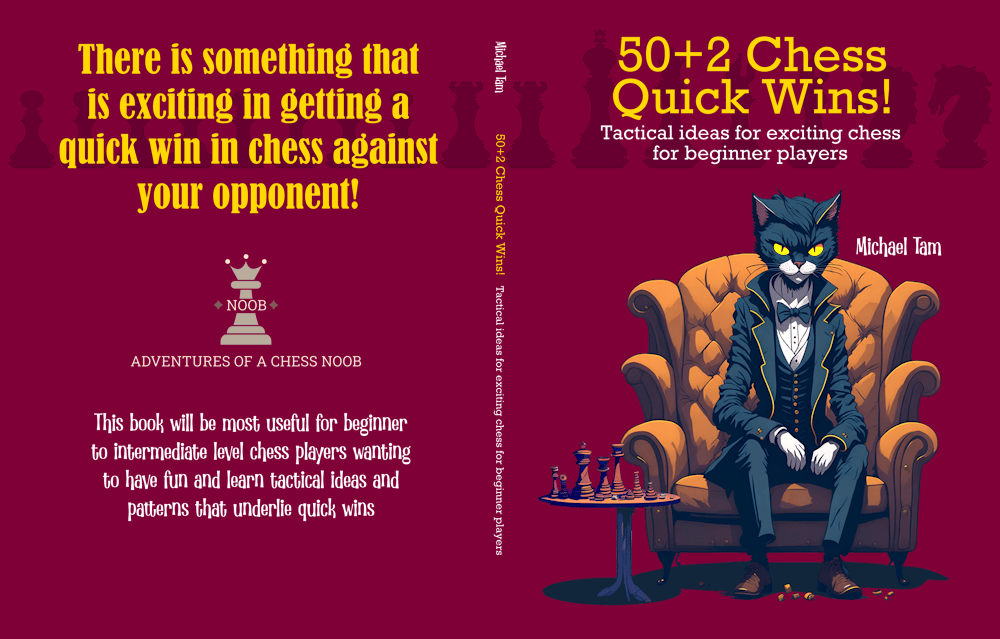
Vienna Game: Main Line, Classical | Tactics for Black 🧐 Game Review #14
#vienna #mainline #gamereview #tacticsforblack
Welcome to another episode of the "chess noob Game Review" series where the focus will be on identifying in how a game, whether I win or lose, could have been improved. This gives me an opportunity to reflect more deeply about a game and hopefully, the lessons that I draw for myself will be helpful to my fellow beginner and beginner-intermediate chess players!
I haven’t made one of these videos and articles in a while, but I think that there are some lessons from the mistakes that I made in this game! I had the Black pieces and my opponent attempted to play the Vienna Gambit against me (1. e4 e5 2. Nc3 Nf6 3. f4). Of course, I enter the best response, the Main Line (3… d5) and White opted to play the Classical Variation of the Main Line with (4. fxe5 Nxe4 5. Nf3).

![]()
Most of my knowledge and experience of the Main Line has largely been down the Paulsen Attack (5. Qf3), which is the most frequently played response, and probably the best response for White. Nonetheless, the Classical is “classical” for a reason – it’s perfectly good!
It was interesting reviewing Black’s options on analysis. There is a great logic in developing the king’s bishop as it immediately gives the option for kingside castling. With White potentially having an attack in the centre, getting the king to safety is good.
Stockfish evaluates that (5… Be7) or (5… Bc5) are the most accurate. Both have their merits and potential downsides. I very much liked Bc5 as there are then two attackers (with our advanced e4-knight) on White’s weak f2-square. Indeed, in the Vienna Game Main Line, White’s loss of the f-pawn creates a significant weakness along the dark f-square diagonal to their king! However, the problem with the immediate Bc5 is White has the obvious (6. d4), which hits the bishop with tempo and solidifies their advanced e5-pawn. Stockfish thinks this is fine, but I didn’t like it. With Be7, it’s a more conservative and subtle approach. It’s a good move, but it wasn’t something that I necessarily gravitated towards.
Interestingly, when we look at the Lichess community database and examine the win-loss ratios, Be7 and the confrontational Bb4 are the most winning, though we’re not talking about big differences.
As noted, I liked Bc5, but felt that it would have more juice with a second attacker of the d4 square. So, I developed my queen’s knight (5… Nc6). This was marginally less accurate [-0.2 → +0.1], but it’s a relatively forcing move! Now, you might be confused… to launch an attack, normally you need one more attacker than defenders. If Black has only two attackers on d4 and White has two defenders, why is it good for Black?
The reason is that White’s f3-knight is rather constrained! That weak dark square diagonal to the white king means that the knight MUST guard against Qh4+! This means that the f3-knight is only notionally defending the d4 square – something that can be exploited by Black! In the position after (5… Nc6), White has a single good move, which is to hobble Black’s knight with a pin (6. Bb5).
White doesn’t see this and plays (6. h3??), a blunder as Black now has (6… Bc5)! Black must play (7. d4) to block the attack on f2, but Black can capture that pawn with impunity (7… Nxd4). If White captures back, a very natural but blunderous move (8. Nxd4??), there is a beautiful, forced checkmate line [-M6] – (8… Qh4+ 9. g3 Qxg3+ 10. Ke2 Qf2+ 11. Kd3 Qxd4+ 12. Ke2 Ng3+ 13. Kf3 (or Ke1) Qf2#).
![]()
A historical note:
One of the earliest games of the Vienna Game: Main Line, 5. Nf3 Nc6 is (Mackenzie — Hollins, 1893, London, England) which contains this blunder by White, where they move their king’s knight, capturing in the centre on d4. It demonstrates the catastrophic impact with a delicious checkmate with a pawn on move 13!
Another beautiful and romantic game of the Vienna Game: Main Line, 5. Nf3 Nc6 is by Austrian chess master Leopold Löwy Jr. (1971-1940) in (NN — Loewy, 1905, Vienna, Austria) who makes use of brilliant sacrificial attacks for checkmate!
This opening can result in relatively positional games as well, and players including Blackburne and Lasker chose the (5… Nc6) variation.
![]()
In this game, I didn’t actually recognise that I could capture Black’s pawn on d4 and played (7… Bb4), losing most of my advantage… 😅 The Vienna Game Main Line can be tricky to play for both White and Black, and my misstep led to a central trade and on move 10 after (10 Qxe4), I knew that I had completely stuffed up! White had an obvious advantage – they held the centre, and I’d somehow lost both my central pawns! 😢
White’s approach should have been to solidify their space advantage with a push of pawns, but this isn’t necessarily an obvious idea at the beginner-intermediate level. By not doing this, I had a potential counterattack by attacking White’s developed queen in the centre of the board and winning some tempo to claw back some of the disadvantage (11… Bd5). White still had their weak kingside dark squares, and this was another avenue of counterattack (12… Bh4+).
The tactical logic? By poking at White’s weaknesses with aggressive threats, I was trying to provoke White to make a mistake. Next move, I gave their bishop a kick (13… a6?!). Stockfish called this an inaccuracy, but it worked! 🤩
Loss aversion is a cognitive bias that afflicts the best of us. The sensible response for White would have been to simplify and trade away their bishop (14. Bxc6+). Simple and clean. However, we hold notions that a “bishop is worth more than a knight” and that we don’t want to give away our bishop pair. In this position, White attempted to counterattack my bishop with (14. c4??). But this was a blunder as I could trade away that bishop with check, winning tempo (14… Bxf3+!) and White’s b5-bishop was still hanging! In essence, they blundered a piece.
One mistake sometimes creates the environment for another. After (15. Qxf3?! axb5), my knight was unpinned and threatening Nxd4+ a royal fork! White saw this and defended the position with (16. Be3). Here, I could win another pawn with (16… Nxd4+) which forces (17. Bxd4 Qxd4). Correct, safe, but perhaps a bit boring. 😏
So instead, I decided to play the deliciously romantic (😍), absolutely mad (🤪), and objectively blunderous (16… Qxd4!?) first! This move returns the evaluation to [0.00] but White must find the correct sequence by “sacrificing” their queen first (17. Qxc6+). Sacrifice is in quotation marks as at the end of the sequence, White takes my queen, and regains a piece, hence, the return to equality. I’d already established that my opponent suffered from a loss aversion bias.
Without a doubt, White would see that the obvious (17. Bxd4) results in an unfavourable trade due to the resulting royal fork (17… Nxd4+). However, by avoiding capturing my queen (which is the second-best move!), I’m once again provoking and inviting them to blunder – and they did (17. cxb5??) [-M7]. After (17… Qxb2+), White was facing losing one or both rooks. To avoid stepping their king onto the back rank, they blocked the check with (18. Bd2), but of course (18… Nd4+) royal fork! Emotional damage, good game, GG!
The big takeaway from this game is being sensitised to tactics that could be used in the early Vienna Game Main Line when playing with the Black pieces, especially exploiting White’s weak dark squares to the king, and the illusory control that their king’s knight has of the d4 square.



